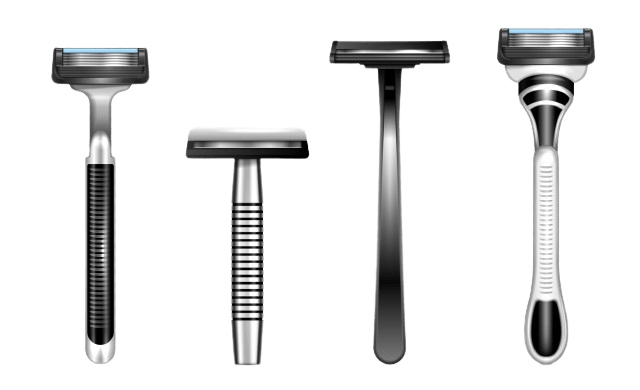- 30 November 2023
- No Comment
- 1233
The Art of Smooth: Gillette’s Business Brilliance Unveiled

The global demand for women’s razors is skyrocketing, with annual sales expected to hit $5 billion by 2028. Products of key players like Gillette’s and BIC’s are strategically positioned to capitalize on this billion-dollar opportunity, as reported by Arizton.
Throughout history, human fascination with physical attractiveness has been intertwined with self-esteem and confidence. Now, as the need for on-the-go grooming solutions and a growing awareness of physical hygiene sweep through both men and women, the demand for disposable razors is reaching new heights.
Once upon a time, in the early 20th century, a man named King Camp Gillette had a revolutionary idea. He wanted to create a razor that was not only safe and disposable but also affordable for the masses. Little did he know that his invention would pave the way for the modern shaving industry and establish Gillette as a household name which is now valued at 6.6 billion U.S. dollars in 2023.
The Birth of a Revolutionary Idea 
In the late 1800s, King Camp Gillette, who invented the razor, experienced the frustration of using traditional straight razors that required constant sharpening and posed a risk of cuts and infections.
Determined to find a better solution, he embarked on a journey to create a razor that would revolutionize the shaving experience, marking when the razor was invented.
Gillette’s quest for a safer and more convenient shaving alternative led him to collaborate with chemist William Emery Nickerson.
Together, they developed the first-ever safety razor and blade, which would become the foundation of the Gillette razor brand’s business model.
Gillette’s Early Success and Expansion
In 1903, marking the first Gillette razor, Gillette introduced its commercial safety razor to the world. The response was overwhelming, and the demand for this innovative product soared.
The United States armed forces even adopted Gillette’s safety razors during World War I, and sold 3.5 million razors and 32 million disposable razor blades to military, solidifying its reputation as a reliable and trusted brand, and adding to the Gillette razor history.
As Gillette’s popularity grew, so did its presence in global markets. The company established manufacturing plants and offices in countries like France, Germany, and England, paving the way for global expansion.
By the 1920s, Gillette’s foreign businesses accounted for a significant portion of its sales.
Setback
However, Gillette’s success was not without its challenges.
In 1921, the company faced a significant setback when its original razor patent expired.
To stay ahead of the competition, the company introduced the New Improved Gillette Safety Razor in spring 1921 and switched to the razor and blade pricing structure the company is known for today.
Despite the introduction of the New Improved razor, Gillette faced stiff competition from other companies that were producing similar products. The company’s sales began to decline, and it was forced to reduce its prices to remain competitive.
Post-War Era
In the post-war era, Gillette swiftly boosted production by modernizing key plants in the US and England, expanding foreign facilities, and reopening war-closed plants.
With a new Swiss plant and blade manufacturing in Mexico City in 1946, sales hit $50 million, selling a billion blades in 1947. By 1950, Gillette dominated 50% of the US blade market. The 1950s saw the company updating and relocating older European factories, such as moving the Paris factory to Annecy.
Acquisition by Procter & Gamble
Over the years, Gillette continued to innovate and improve its products, introducing new razor designs and expanding into other personal care categories. In 2005, the American multinational corporation Procter & Gamble (P&G), who owns Gillette, recognized the potential of Gillette’s brand and acquired the company for a staggering $57 billion, marking one of the most significant mergers acquisitions.
In 2005–2006, Gillette unveiled the revolutionary Fusion, the world’s first 5-blade razor, as its inaugural release post-P&G acquisition.
By 2010, Fusion had become the top-selling blade and razor brand globally, achieving $1 billion in annual sales at a record pace for any prior P&G product.
Procter & Gamble’s net sales for the fiscal year 2022 were slightly over 80 billion U.S. dollars.
Gillette’s brand value added up to approximately 6.6 billion U.S. dollars in 2023, which is slightly down from the previous years. In comparison, the brand’s valuation amounted to about 7.55 billion U.S. dollars in 2021
How Gillette Makes Money
The renowned brand, known for its safety razors and personal care products, has multiple revenue streams that contribute to its success. Let’s dive into how Gillette manages to rake in the dollars and maintain its dominance in the market.
Sales: Shaving Equipment and Products
One of the primary ways Gillette makes money is through the sale of its shaving equipment and shaving products. Men and women across the globe rely on Gillette razors to achieve a smooth and close shave, accounting for 50% global share.
By offering a wide range of razor options, from disposable ones to high-end electric shavers, Gillette caters to different customer preferences, ensuring a steady stream of sales.
Oral Care Products: Production and Sales
Gillette recognizes the importance of oral hygiene, and as a result, they have expanded their product line to include oral care items.
From toothbrushes to toothpaste, the company offers high-quality products that help customers maintain a healthy and confident smile. With the increasing demand for oral care products, Gillette has tapped into this market to boost its revenue.
The global oral care market was valued at a substantial US$ 38.3 billion in 2022, projected to US$ 42.9 billion by 2029.
Personal Care Items
In addition to shaving and oral care products, Gillette also sells a variety of personal care items. This includes deodorants, body washes, and skincare products. By providing these products, Gillette caters to the grooming needs of its customers beyond just shaving, further diversifying its product offerings and increasing its revenue potential.
E-commerce Strategies: Gillette’s Online Presence
With the advent of the digital age, Gillette has adapted to the changing market landscape by embracing e-commerce, which generated $21.2 million in online revenue in 2022.
The company leverages its website and online marketplaces to reach a wider customer base and facilitate direct sales. By embracing online shopping trends, Gillette ensures that its products are easily accessible to customers worldwide, contributing to its financial success.
Licensing Initiatives: Building Brands Beyond Razors
Gillette recognizes the value of its brand name and intellectual property (IP). To capitalize on this, the company licenses its trademarked brand name and logo to third-party companies that produce and sell razors, shaving creams, and other personal care items.
This means that Gillette earns royalties or fees from licensing agreements, creating an additional revenue stream.
Partnership and Collaboration Impact: Shaping Success
Gillette generates income by forming strategic partnerships and collaborations with other companies in the industry.
By leveraging its brand, expertise, and technology, Gillette is able to create alliances that expand its market reach and product offerings. This allows them to tap into new customer segments and generate additional revenue. International
Global Outreach
While Gillette’s roots are in the United States, the company has a strong global presence. It sells its products in over 200 countries worldwide, partnering with local distributors and retailers.
By understanding local markets and adapting to cultural preferences, Gillette reaches a broader customer base, with international sales playing a significant role in its revenue generation.
Gillette’s Pricing Model
Gillette’s “razor and blades” pricing model is legendary. It draws people in with an attractively priced razor, then repeatedly charges them for expensive replacement blades.
Before King Camp Gillette, razors were bigger, chunkier affairs – and a significant enough expense that when the blade got dull, you would sharpen—or “strop” – it, not chuck it away and buy another.
Gillette realized that if he devised a clever holder for the blade to keep it rigid, he could make the blade much thinner—and hence much cheaper to produce.
Gillette’s two-part pricing model has become ubiquitous in the modern economy. For example, photocopy machine manufacturers: The manufacturers sell the photocopy machine at a low price and then charge a premium for the ink cartridges.
This pricing model allows manufacturers to make a profit on both the machine and the ink cartridges. Customers are often willing to pay the premium for the ink cartridges because they need them to operate the machine.
Gillette’s Business Model Canvas
To understand the inner workings of the Gillette business model, let’s delve into the key components of the Business Model Canvas, a crucial part of the Gillette model.
Customer Segments:
- Individuals, small and medium businesses, retailers, and large corporations
- Men and women seeking quality shaving and personal care products
- Partnerships with retailers, distributors, and organizations for market expansion
Channels:
- Convenience stores, supermarkets, healthcare stores, and online shopping sites
- Direct response webpage and e-commerce for browsing, ordering, and subscriptions
Customer Relationships:
- Personalization, premium benefits, and exceptional customer service
- Soliciting feedback and building a community through social media and online forums
- Establishing trust and loyalty by engaging with customers and addressing their needs
Key Resources:
- Human resources, branding, and marketing capabilities
- Research and development expertise, large distribution network
- Manufacturing facilities, patents, and intellectual property
Gillette Stadium, home of the New England Patriots of the NFL, is named after the company as part of a naming rights deal. The deal runs through 2031, and Gillette pays $7 million annually for the naming rights
Gillette’s Competitors and SWOT Analysis
In the highly competitive personal care industry, Gillette faces competition from industry giants like Colgate-Palmolive, Energizer Holdings, Societe BIC, as well as new entrants like Dollar Shave Club. Each competitor brings its unique offerings and strategies to capture a share of the market.
To assess Gillette’s position in the industry, let’s conduct a Gillette SWOT analysis.
Strengths
- They have a long history and established brand recognition. When you think of shaving, you think of Gillette.
- Their products are known for their quality and performance. They’ve earned the trust of millions of customers around the world.
- Gillette has a strong distribution network, allowing them to reach customers in over 200 countries.
Weaknesses
- Some customers perceive their products as overpriced compared to competitors.
- They have faced backlash in recent years for their environmental impact, as disposable razors contribute to plastic waste.
Opportunities
- There is still room for growth in emerging markets, where shaving habits are evolving.
- Increasing demand for grooming products and personal care items presents an opportunity for Gillette to expand their product offerings.
Threats
- There is intense competition from both traditional players and disruptive newcomers in the industry.
- The rise of beards and facial hair trends has challenged the traditional shaving market.
Gillette’s Value Propositions
Tailored Value Propositions for Small and Medium Businesses
-
High-Quality Products:
Gillette ensures strict quality control processes in the supply of its products to small and medium-sized businesses. This means that businesses can trust that they are receiving high-quality goods that will enhance their reputation and customer satisfaction.
-
Efficiency:
With a network of strategically located warehouses and distribution centers, Gillette guarantees fast and reliable delivery to small and medium businesses. They also offer bulk discounts, allowing these businesses to save more money and allocate resources efficiently.
-
Consistency:
Gillette maintains a series of standardized processes to ensure consistent relationships between their brand and small and medium-sized businesses. This consistency helps foster trust and reliability in business partnerships.
-
Affordability:
Understanding the tight budgets of small businesses, Gillette offers wholesale pricing for bulk purchases, enabling them to sell at a lower unit price. This cost advantage helps attract more customers for these businesses.
Strategic Value Propositions for Large Corporations
-
Quality and Performance:
As a leader in the industry, Gillette produces high-quality razors and shaving products that meet the highest standards. Large corporations can trust that Gillette’s products will provide a superior shaving experience for their employees or clients.
-
Innovation and Technology:
Gillette constantly invests in research and development to introduce innovative technologies and designs to its products. This commitment to continuous innovation ensures that large corporations can offer their employees the latest advancements in shaving technology.
-
Diversified Product Line:
Apart from safety razors, Gillette has expanded its product line to include a wide range of personal care items. This diverse offering allows large corporations to source all their personal care needs from a trusted and reliable partner.
By delivering on these value propositions, Gillette positions itself as a preferred choice for both small and medium businesses as well as large corporations.
Whether it’s through offering high-quality products at affordable prices or providing innovative, cutting-edge solutions, Gillette caters to the unique needs of different customer segments.
So why settle for anything less when you can have the best? Choose Gillette for your grooming and personal care needs!

Nabeel Shaikh’s Expert Perspective on Gillette’s Business Model
Gillette, the trailblazer in the shaving industry since the invention of the safety razor, has seamlessly blended quality, innovation, and customer satisfaction for over a century.
As a seasoned market leader, the company has consistently evolved, adapting to the ever-changing landscape of consumer preferences.
Driven by strategic partnerships, relentless research and development, and an unwavering global presence, Gillette stands as a beacon of innovation in the personal care industry.
Its commitment to pioneering shaving technology ensures a future where the shaving experience is not just a routine but a safer, more comfortable, and more accessible ritual.
In a world where consumer needs shift like the tide, Gillette remains at the forefront, embracing new technologies and setting the stage for the next era of shaving innovation.
So, when you hold a Gillette original razor, you’re not just holding a tool; you’re holding a piece of history and a business model that has shaped an iconic brand in personal care.
Gillette isn’t merely about shaving; it’s about empowering individuals to look and feel their best, one razor at a time.
With a diverse product line tailored to the modern man, the Gillette company exemplifies strategic vision, as seen in the Gillette case study and its innovative approach to subscription shaving.



